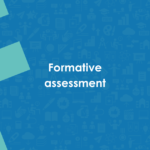
06 Feb Constructive alignment focused on learning
Your students have completed two out of four years of education and are doing an internship. Suddenly you hear them say, “I had to conduct consultations during my internship, but we never learned that in school!”. Even though you had put so much time and attention into that course on counseling and all the students had passed their exams or tests. How could they have forgotten this? Perhaps there is something wrong with the constructive alignment of your teaching.
Constructive alignment seems to be an open door in education: your goal, assessment and learning activities should be in line with each other. We already hear many teachers in teacher training say: of course you want that, why should we do something completely different in our teaching than we intend? Yet in practice, actually achieving constructive alignment is not as easy as it seems. We offer some tips.
Background
To fully understand the importance attached to the idea of constructive alignment, we first dive into history. Constructive alignment as a concept was first mentioned by John Biggs in the 1990s¹. Biggs views learning from a constructivist point of view, which states that learning is an active process in which the learner also has a stake. Thus, according to this theory, learning does not happen by simply “sending” information to a student, but the student will still have to actively process this information in order to learn.
For higher education (especially universities) this meant that rather than simply sending information to a lecture hall, education had to start from the intrinsic motivation of students. Constructive alignment was mainly about making the conversation more about students’ learning activities: were they still the right ones, and did they match with what you want to achieve with students?
Biggs cites the following example:
“In my last year of teaching, I had a class of 82 schoolteachers who were studying how psychology could be applied to teaching. It suddenly struck me how silly it was to give the usual exam or final assignment, in which my students tell me what I had told them about applying psychology to education. Rather, they should be telling me how they themselves could apply what psychology they knew to improve their teaching decisions – that was the underlying intended outcome of the course.”²
In short, constructive alignment assumes an active role of the student in the learning process, and that student must therefore be taken into account if learning is to occur. From this assumption, it is good to think about the activities you perform with students to achieve the goals in your teaching.
Thinking about learning outcomes and verbs
The conversation in constructive alignment is primarily about what you want to teach students, i.e., your curriculum and goals. Getting clear exactly what you want to teach students requires quite a bit of thinking and is certainly not easy. Biggs himself mentions the importance of using the right verb here. For example, if you would like students to learn to work together, you could mean several things. Do you mean that they understand how it should actually be done, but don’t mind if they can’t do it so well themselves yet because they can continue learning in the workplace? Or do you want them to actually perform good collaboration skills already in training because it is essential in the later profession they will enter? Thinking from verbs can help to make concrete with each other what you expect from students.
Thinking about learning outcomes from constructive alignment is meant to later design your learning activities and assessment to promote teaching and student learning. So the focus is not on accountability for what your students can and cannot do. This is still sometimes confused with each other, leading you to hear statements such as “you must formulate learning objectives as measurable as possible. While being specific is certainly helpful, ‘measurable’ can sometimes give the wrong focus. Think carefully about whether you are in the process of making learning outcomes measurable for accountability purposes, or whether you are in the process of promoting learning³. About formulating concrete learning goals, we previously wrote this article.
Moving on to learning activities and assessment
Once you know what you actually expect from students, you can design your learning activities and testing or assessment to hopefully achieve the goals as much as possible. For example: Once you know that students must have mastered collaboration skills during the program and therefore must perform this skill, it will not make much sense to teach this skill based on theory and case studies alone. Having students actually work together in different situations and actively supporting them in doing so sounds like an essential addition then.
The same goes for evaluation or testing: if you want to achieve constructive alignment, you ultimately evaluate students on performing those collaboration skills, not on recognizing or reflecting on them. Recognizing and reflecting are different goals. Biggs himself sums it up nicely, “Students learn what they think they are being evaluated on.” So the best way to ensure that students learn what you really want them to learn is to make exactly that (and not something else) part of the evaluation and of your learning activities. In short: constructive alignment is a logical theory but also an interesting practical puzzle.
And now your students…
Once you yourself have a good picture of the alignment between learning outcomes, learning activities and assessment or testing, it is important that your students form that picture as well. A good sense of quality is critical to getting clear on exactly what you mean by a learning outcome. What level is expected, what does such a learning outcome mean concretely in an elaborated assignment? By comparing different student works you can quickly and very concretely make clear what you mean. This comparing works easily in the Comproved comparing tool. Learn more about it here.
¹Biggs, J. (1996). Enhancing teaching through constructive alignment. Higher Education, 32, 347-364. https://doi.org/10.1007/BF00138871
²Biggs, J. (n.d.). Constructive alignment. Verkregen via https://www.johnbiggs.com.au/academic/constructive-alignment/
³Loughlin, C., Lygo-Baker, S., & Lindberg-Sand, A. (2020). Reclaiming constructive alignment. European Journal of Higher Education, 11(2), 119-136. https://doi.org/10.1080/21568235.2020.1816197




